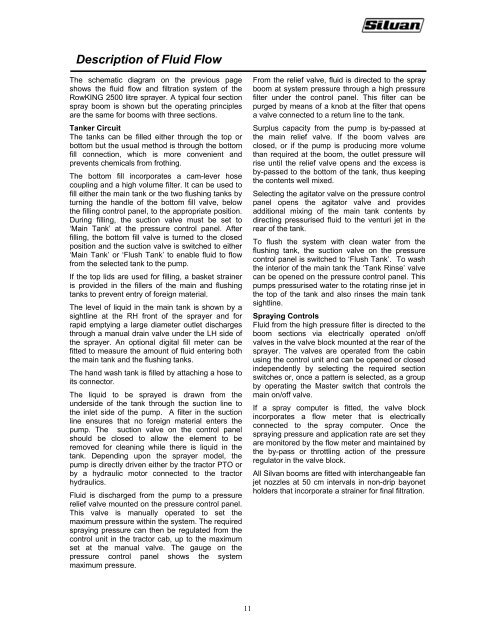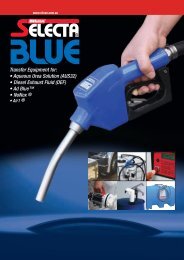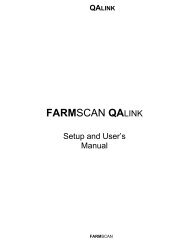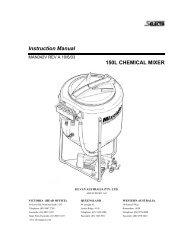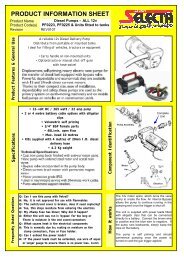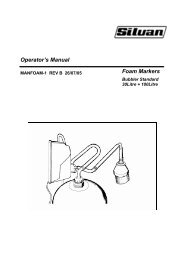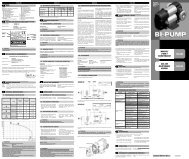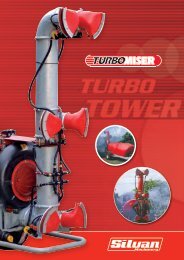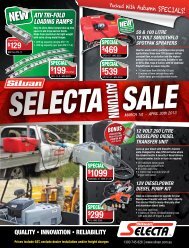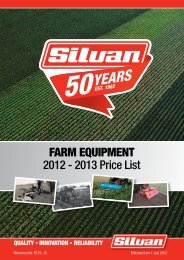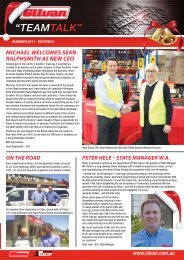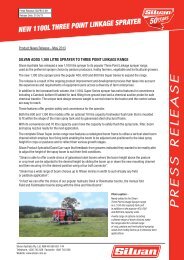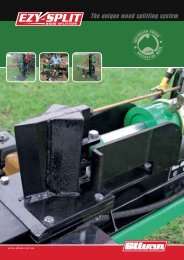Download Manual - Silvan Australia
Download Manual - Silvan Australia
Download Manual - Silvan Australia
You also want an ePaper? Increase the reach of your titles
YUMPU automatically turns print PDFs into web optimized ePapers that Google loves.
Description of Fluid Flow<br />
The schematic diagram on the previous page<br />
shows the fluid flow and filtration system of the<br />
RowKING 2500 litre sprayer. A typical four section<br />
spray boom is shown but the operating principles<br />
are the same for booms with three sections.<br />
Tanker Circuit<br />
The tanks can be filled either through the top or<br />
bottom but the usual method is through the bottom<br />
fill connection, which is more convenient and<br />
prevents chemicals from frothing.<br />
The bottom fill incorporates a cam-lever hose<br />
coupling and a high volume filter. It can be used to<br />
fill either the main tank or the two flushing tanks by<br />
turning the handle of the bottom fill valve, below<br />
the filling control panel, to the appropriate position.<br />
During filling, the suction valve must be set to<br />
‘Main Tank’ at the pressure control panel. After<br />
filling, the bottom fill valve is turned to the closed<br />
position and the suction valve is switched to either<br />
‘Main Tank’ or ‘Flush Tank’ to enable fluid to flow<br />
from the selected tank to the pump.<br />
If the top lids are used for filling, a basket strainer<br />
is provided in the fillers of the main and flushing<br />
tanks to prevent entry of foreign material.<br />
The level of liquid in the main tank is shown by a<br />
sightline at the RH front of the sprayer and for<br />
rapid emptying a large diameter outlet discharges<br />
through a manual drain valve under the LH side of<br />
the sprayer. An optional digital fill meter can be<br />
fitted to measure the amount of fluid entering both<br />
the main tank and the flushing tanks.<br />
The hand wash tank is filled by attaching a hose to<br />
its connector.<br />
The liquid to be sprayed is drawn from the<br />
underside of the tank through the suction line to<br />
the inlet side of the pump. A filter in the suction<br />
line ensures that no foreign material enters the<br />
pump. The suction valve on the control panel<br />
should be closed to allow the element to be<br />
removed for cleaning while there is liquid in the<br />
tank. Depending upon the sprayer model, the<br />
pump is directly driven either by the tractor PTO or<br />
by a hydraulic motor connected to the tractor<br />
hydraulics.<br />
Fluid is discharged from the pump to a pressure<br />
relief valve mounted on the pressure control panel.<br />
This valve is manually operated to set the<br />
maximum pressure within the system. The required<br />
spraying pressure can then be regulated from the<br />
control unit in the tractor cab, up to the maximum<br />
set at the manual valve. The gauge on the<br />
pressure control panel shows the system<br />
maximum pressure.<br />
From the relief valve, fluid is directed to the spray<br />
boom at system pressure through a high pressure<br />
filter under the control panel. This filter can be<br />
purged by means of a knob at the filter that opens<br />
a valve connected to a return line to the tank.<br />
Surplus capacity from the pump is by-passed at<br />
the main relief valve. If the boom valves are<br />
closed, or if the pump is producing more volume<br />
than required at the boom, the outlet pressure will<br />
rise until the relief valve opens and the excess is<br />
by-passed to the bottom of the tank, thus keeping<br />
the contents well mixed.<br />
Selecting the agitator valve on the pressure control<br />
panel opens the agitator valve and provides<br />
additional mixing of the main tank contents by<br />
directing pressurised fluid to the venturi jet in the<br />
rear of the tank.<br />
To flush the system with clean water from the<br />
flushing tank, the suction valve on the pressure<br />
control panel is switched to ‘Flush Tank’. To wash<br />
the interior of the main tank the ‘Tank Rinse’ valve<br />
can be opened on the pressure control panel. This<br />
pumps pressurised water to the rotating rinse jet in<br />
the top of the tank and also rinses the main tank<br />
sightline.<br />
Spraying Controls<br />
Fluid from the high pressure filter is directed to the<br />
boom sections via electrically operated on/off<br />
valves in the valve block mounted at the rear of the<br />
sprayer. The valves are operated from the cabin<br />
using the control unit and can be opened or closed<br />
independently by selecting the required section<br />
switches or, once a pattern is selected, as a group<br />
by operating the Master switch that controls the<br />
main on/off valve.<br />
If a spray computer is fitted, the valve block<br />
incorporates a flow meter that is electrically<br />
connected to the spray computer. Once the<br />
spraying pressure and application rate are set they<br />
are monitored by the flow meter and maintained by<br />
the by-pass or throttling action of the pressure<br />
regulator in the valve block.<br />
All <strong>Silvan</strong> booms are fitted with interchangeable fan<br />
jet nozzles at 50 cm intervals in non-drip bayonet<br />
holders that incorporate a strainer for final filtration.<br />
11


